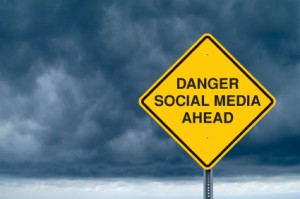Will Social Media Make You Crazy?

This person has been edited.
Social media has been getting a bad rap in the press recently. First, there’s The Innovation of Loneliness, a terrific short film (just over four minutes) by Shimi Cohen. It suggests that one of the key differences between real life and social-media life is the ability to edit. We can edit ourselves on social media and put our best foot forward. Not so in real life and, according to Cohen, that’s what makes real-life superior. Simply put: you interact with real people, not edited people.
Cohen — whose film is based on Sherry Turkle’s book Alone Together – urges us to slow down and have actual conversations with others. He also explains (though never names) the concept of Dunbar’s Number – that humans naturally organize themselves into groups of 150 or less. He implies that any group larger than 150 is too much for the human mind to handle. So what’s the point of having, say, 500 friends on Facebook?
Cohen’s film reminded me of the many articles I’ve read on mindfulness recently. For instance, Scientific American Mind recently led with mindfulness as its cover story. I’ve also been reading Mindfulness for Beginners by Jon Kabat-Zinn. The common thread is the admonition to slow down and, as Kabat-Zinn phrases it, “reclaim the present moment.” These writings don’t specifically suggest that social media is bad for you but it’s an easy conclusion to draw.
A research article recently published in the Public Library of Science (PLoS) is much more specific. In fact, its title pretty much says it all: “Facebook Use Predicts Declines in Subjective Well-Being Among Young Adults”. (The original research paper is here. For non-technical summaries, click here for an article from The Economist or here for one from the L.A. Times).
The study tracked 82 young people as they used Facebook. They were also asked to report their “satisfaction with life” at the beginning and end of the study. Bottom line: “…the more they used Facebook [during the study period], the more their life satisfaction levels declined over time.”
The PLoS study doesn’t identify the causes in decline of life satisfaction. But The Economist points to an earlier study to identify a likely culprit. The study, conducted in Germany, found that “…the most common emotion aroused by using Facebook is envy”. The Economist makes essentially the same point that Shimi Cohen does:
Endlessly comparing themselves with peers who have doctored their photographs, amplified their achievements and plagiarised their bons mots can leave Facebook’s users more than a little green-eyed. Real-life encounters, by contrast, are more WYSIWYG (what you see is what you get).
So should we drop social media? As I wrote several months ago, I still think it’s a good way to stay in touch with our “Christmas card friends” – those friends whom we like but don’t see very often. For our bosom buddies, on the other hand, it’s probably better to just slow down and have a nice, mindful heart-to-heart conversation.
Teens Dump Social While Companies Rush In
 Last month a Piper Jaffray survey asked 5,000 teenagers in the United States to identify their “most important social media sites.” Facebook was still the most important but it had declined steeply compared to Piper Jaffray surveys taken six months and 12 months earlier. Indeed, Facebook was barely ahead of YouTube.
Last month a Piper Jaffray survey asked 5,000 teenagers in the United States to identify their “most important social media sites.” Facebook was still the most important but it had declined steeply compared to Piper Jaffray surveys taken six months and 12 months earlier. Indeed, Facebook was barely ahead of YouTube.
Why did it happen? Well, teenagers are fickle. Additionally more and more old folks are invading the Facebook space, which may be driving the younger set away. Advertising may be partially to blame as well. As I learned with my brief foray into Facebook advertising, a lot of users react violently to the presence of ads in their news feeds.
Overall, however, I think the most cogent analysis comes from Cliff Watson’s blog on Medium. Watson essentially says that teens have better things to do and faster, simpler ways of doing it.
As the teens decamp, however, companies are rushing into social media. In March, McKinsey published its sixth annual survey on the business use of social media. The survey, conducted in 2012, received responses from 3,542 executives representing companies around the world. Some 83 percent of respondents say their companies are using at least one social medium (up from 72 percent in 2011) and 90 percent of those report measureable benefits.
Companies are using social media both internally and externally. The top benefits for internal use (in order) are: 1) faster access to knowledge; 2) reduced communication costs; 3) reduced travel costs. For external use, the top three benefits are: 1) increased marketing effectiveness; 2) increased customer satisfaction; 3) reduced marketing costs.
This also seemed to be the year that companies jumped on the mobile bandwagon. Sixty-five percent of the respondents said their companies were using at least one social medium on mobile technologies. As in previous surveys, the three primary uses for mobile were: 1) marketing; 2) sales; 3) IT.
While mobile is growing rapidly, the use of big data is more of a challenge. Indeed, executives don’t quite seem to know what to make of big data. According to McKinsey, “ … between 42 and 54 percent of respondents say either that they don’t know how their companies use the data or that these practices aren’t yet applicable to their companies.”
And the downside? A majority of respondents say that the major risk is that confidential information may be leaked. But 60 percent agree that the benefits outweigh the risks.
Teens seem to be moving away from “traditional” social technologies while companies are moving in. Coincidence? I think not. It’s like two animals competing for the same ecological niche. As one moves in, the other moves out. That’s not necessarily a bad thing. Companies can still get a lot of benefits from social media. They just won’t get the teens.
Social Media for Business Leaders
 As a marketing guy, I understand (sort of) the marketing aspects of social media. If you can start a conversation — and keep it interesting — you can engage your market in ways that are impossible with “interruption marketing”. You can exchange ideas, gather suggestions, support charities, and engage in positive social activities. Along the way, you can mention your products. You offer something of interest (or utility) and the products tag along for the ride.
As a marketing guy, I understand (sort of) the marketing aspects of social media. If you can start a conversation — and keep it interesting — you can engage your market in ways that are impossible with “interruption marketing”. You can exchange ideas, gather suggestions, support charities, and engage in positive social activities. Along the way, you can mention your products. You offer something of interest (or utility) and the products tag along for the ride.
But social media is not just about marketing. Executives should be able to use social media to enhance both internal and external communication. Yet, I haven’t found many examples in the literature. Fortunately, McKinsey just published an interesting case study based on GE’s experience. The authors, who are GE leaders themselves, point out that GE is not a “digital native” and its experiences may, therefore, be relevant to a wide range of organizations. They then outline six social media skills that all leaders need to learn. The first three are personal; the last three are strategic or organizational.
Producer — creating compelling content. Digital video tools are now widely available and easy to use. Even busy senior executives can weave them into their communications. As compared to traditional top-down communications, the emphasis shifts from high production quality to authenticity. The goal is to invite participation and collaboration. Speaking plainly and telling stories in an authentic voice invites participation much better than a highly produced video.
Distributor — leveraging dissemination dynamics. Instead of sending a message and expecting it be consumed, you now send a message and expect it to be mashed up. A successful social message will be picked up by people at all levels of the organization, commented on, “recontextualized”, and forwarded along. You want this to happen which means giving up a significant amount of control — not always an easy concept for executives. You also want to build up a followership within the organization long before you need it.
Recipient — managing communication overflow. We’re already drowning in information. Why take on social media? Because it’s more credible than top-down media. By learning to use filters effectively, you can also use social media to manage the flow of information to and from your desk. You should practice when and how to respond to postings and tweets. You don’t need to respond frequently but you do need to respond thoughtfully.
Advisor and orchestrator — driving strategic social media utilization. Fundamentally, executives need to promote the use of social media and guide it to maturity. Your company may be enthusiastic but inexperienced. Or you may have leaders who wish to avoid it altogether. A good leader can harness the enthusiasm of “digital natives” and even use them as “reverse mentors” to build capabilities within the organization.
Architect — creating an enabling organizational infrastructure. On the one hand, you want to encourage collaboration and free exchange. On the other hand, you need some rules. It helps if you have well-established values of integrity, collaboration, and transparency. If your company hasn’t established these values, it’s time to get started. Social media will arise in your organization whether you’re ready or not.
Analyst — staying ahead of the curve. As your organization masters social media, something new will emerge. Perhaps, it’s the Internet of Things. As I’ve noted before, this could help us reduce health care costs. It could also have huge implications for your organization — both good and bad. Better stay awake.
And what do you get if your company’s leaders master these skills? The authors say it best: “We are convinced that organizations that … master … organizational media literacy will have a brighter future. They will be more creative, innovative, and agile. They will attract and retain better talent, as well as tap deeper into the capabilities and ideas of their employees and stakeholders.”